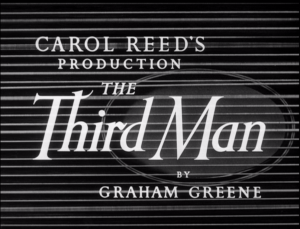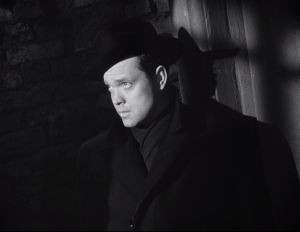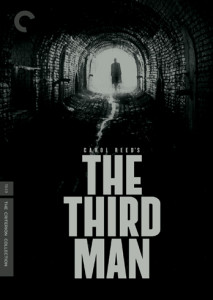This post is part of the Criterion Blog-a-thon, hosted by Kristina at Speakeasy, Ruth at Silver Screening, and Aaron at Criterion Blues. Click HERE for the full roster for the event!
Harry Lime is dead. That is ALL YOU NEED TO KNOW and it would probably be in your best interest to click away right now.
I see that you want to stick to it and dig around. You are not willing to accept my assurance that Harry Lime is dead. So be it. Readers please note that this essay contains spoilers; however the film is sixty-six years old and that is more than enough time to be viewed thus I do not consider this my problem. (If this is a problem for you feel free to look at this picture of a cat, since Harry Lime is dead, after all)
The Third Man is a 1949 film directed by Carol Reed, written by Graham Greene and starring Joseph Cotten, Alida Valli, Trevor Howard but definitely not Orson Welles (because Harry Lime is dead). The film takes place in a battle-worn Vienna, Austria and tells the story of Holly (Rollo*) Martins (Joseph Cotten) looking for his childhood friend Harry Lime (Orson Welles). It is a co-production between British Lion films and Selznick Releasing.
Soon after arriving in Vienna, Martins learns that Lime was killed when struck by a motorist and the authorities have no interest in investigating the murder; Lime was a notorious racketeer and the city is better off with him dead. Martins is not willing to accept the murder of his chum and starts digging and finding flaws in the various stories leading to a mysterious third man for whom nobody is looking. It is important to note, however, that Lime’s racket was in penicillin which was something that is badly needed in Vienna at the time as the population was slowly starving to death, leaving them all-the-more susceptible to disease.
During his investigations Martins meets a curious cast of characters including Anna (Alida Valli), Lime’s girlfriend, The Baron (Ernst Deutsch) a friend and Dr. Winkel (Erich Ponto) Lime’s doctor.
It is not until one hour and six minutes into the film that we learn that I have been lying to you this whole time and Harry Lime is revealed alive and well (if not incorrigible).
Lime faked his death to evade Major Calloway (Trevor Howard) and continue his penicillin racket. Martins soon confronts Lime on the Wiener Riesenrad, a landmark Ferris wheel which proved resistant to destruction during the war.
All of this culminates in a famous chase scene in the Vienna sewers, which is more of a catacomb than our common notion of a sewer. The lighting and sound design of that scene alone is worth your time to watch the film. The story ends as all noir films should, but I will leave that for you to enjoy.
According to the BFI, The Third Man is the number one British film ever made, a worthy title putting it above several David Lean, Alfred Hitchcock and (my favorite) Powell and Pressburger films. Do I think it is the best British film? No. It is an absolutely great picture, I wouldn’t suggest otherwise, and this is a similar feeling that I have towards Citizen Kane’s top spot in the AFI list.
My rating of The Third Man is 7.9 a very respectable score tying it at number twenty-six on my personal, and woefully incomplete, list. The film does capture the emotions that I have always attributed to classic noir film, that wrenching feeling deep in your gut that the sword is about to fall on Damocles at any moment. There are few films that have kept me on edge for so long, even after several viewings, the little bits and pieces that eventually show themselves all add great value to the film.
Supplements
Disc 1
Introduction by Peter Bogdanovich: This supplement is a wonderful chance to watch Peter Bogdanovich gush over Orson Welles. While he doesn’t state outright that Welles assisted on the actual direction of the film he certainly feels that Reed, like all directors, could not escape Welles’ history-making Citizen Kane and that it may have well had an effect on Reed’s direction on The Third Man.
He did pass along something interesting that Welles once told him, stating that Harry Lime is what he called a “star part.” He explained that a star part is the sort of character about whom everyone is talking for an hour before anyone even seems them.
Commentary with Steven Soderbergh and Tony Gilroy: The top-billed commentary is an interesting pop-commentary with directors Steven Soderbergh (Sex, Lies, and Videotape) and Tony Gilroy (Michael Clayton). I say “pop-commentary” as neither had anything to do with the actual film aside from being longtime students of the medium. They offered some insights into the various filmmaking techniques. At one point Soderbergh says that The Third Man is, in a sense, film-making 101 in a box, suggesting that by studying this one film, alone, you will be able to make a movie. Not a good movie, necessarily, but a movie none-the-less.
Commentary with Dana Polan: The second commentary was much more interesting to me. Dana Polan is a film scholar, currently a professor at NYU, and an author of 8 books. He looks at the film on a more philosophical level. He postulates various theories such as the Dutch angles, in which the camera is tilted (see below), are used to simulate a broken world, or Holly Martins, historically, feminine name being a counterpoint for Welles’ masculine Harry.
These two commentaries comment on the hopelessness of Martins’ character in all areas, especially when it comes to a possible relationship with Anna.
For the sake of completeness I also listened to the commentary on the StudioCanal Collection edition. This commentary is a conversation with assistant director Guy Hamilton and second unit continuity director Angela Allen. It is an interesting third alternate commentary with a couple of people who were actually present during filming. They mostly gush about working with Reed, how difficult it was with Welles, and point out various film elements that they were responsible for.
This edition of the film is also a prime example of how much time and effort The Criterion Collection puts into their releases. Comparing my DVD viewing experience against the StudioCanal Blu-ray I would gladly watch the DVD.
Abridged recording of Graham Greene’s treatment: This track is quite interesting as Greene’s treatment is written from the perspective of Callaway. It seems that he is either giving testimony, or writing a long report, on the happenings of the story. You can read the entirety of Greene’s novelization which he filled out from the treatment. It is available on paperback, Kindle, and Audible if you want the whole story.
*In the original treatment Holly Martins was known as Rollo Martins, a name that Selznick demanded be changed.
Disc 2
Shadowing The Third Man is a ninety-minute feature documentary on the making of the film. This highlights something that none of the commentaries spent much time on, the peculiar relationship of a co-production between British Lion Films and Selznick Productions. Selznick is one of those names with which many people knowledgeable of early Hollywood would be familiar. He was a producer of King Kong, a handful of Hitchcock’s pictures, and was the recipient of 21 Academy Awards. His influence was nearly as strong as his addiction to amphetamines.
The distance between Selznick in Los Angeles and Reed in England is one of the key reasons that Reed was able to make the movie his way with only a few changes between the International and the US releases of the picture.
The documentary also features several clips of Graham Greene discussing various aspects of his time writing the screenplay.
Graham Greene: The Hunted Man: This is an hour long biographical spotlight on Graham Greene containing an interview with Greene, as well as a few clips from some of his produced screenplays.
Who Was the Third Man: This is a half-hour long German documentary created for 50th anniversary of the film. There is not much new information in this supplement. At some point I recall hearing that this was produced by the sewer police as a gift for the city. It may be a legend, but it would be a pretty unique legend.
The Third Man on Radio: You can find 52 episodes of The Lives of Harry Lime on the website archive.org. I listened to a few and they are fairly standard classic radio drama, with tons of zither, if you are into that sort of thing.
Illustrated Production history: At this point in the supplements there is not much new information, but there are some great behind the scenes photographs.
Joseph Cotton’s alternate opening: The difference between the two openings is fairly significant. This was one of Selznick’s few demands for the US release. Some of the more tawdry details that Carol Reed included in the original were cut out. To Selznick’s credit, it added a sense of continuity to the film since he had Joseph Cotten record the introduction. It does however cut out of a little of the Italian Neo-Realism flair that some people felt Reed was attempting to inject.
A look at the untranslated foreign dialogue: This short supplement may be my favorite. I find it fascinating that they chose to leave the foreign dialogue untranslated to simulate how out of place Martins must have felt. It introduces a different take on the forced heroics of the film and a small sampling of how it might feel to be an occupied people.
Trailer: Is a trailer.
https://www.youtube.com/watch?v=Ihlku1aKpRg
It is certainly worth stating that in watching The Third Man any number of times over a condensed time-frame it is very likely that you will foster an intense dislike of the zither, only being able to remember the Monty Python Cheese Shoppe sketch hearing John Cleese scream “Shut that bloody bouzouki up!”





I really found your commentary on the commentary interesting. You’re right – any self-respecting cinephile has already seen THE THIRD MAN, so discussing the film at this point is a bit superfluous unless a really interesting angle can be brought to it. Learning what Criterion thought needed to be said was very enlightening. And I love the cat picture! What a great idea!
Great review of the material AND the Extras! Interesting to see that the radio shows are included, too. Hmm… I think I’ll have to start dropping some pretty big hints around my house…
Thanks for joining the blogathon, and for bringing Harry Lime to the party.
Whoops – i mean, great review of the movie and the Extras. Sheesh.
Really interesting about the various commentaries, and liked your assessment of the supplements, there’s always something new to learn even with essentials like this. (Couldn’t resist the cat picture either). Thanks for taking part in the blogathon.
Great essay, and I echo the other comments thanking you for delving into the supplements. This disc is out of print and a rare commodity, so I’m sure a lot of people appreciate that. I have an unopened version. I also have the StudioCanal version, which shows what I think of the film. I agree that there are better films, and I also agree that some of those films are directed by Powell & Pressburger, but I think this is one of the very best noirs. And thank you for the zither warning. I’ve spaced out my viewings and will continue to do so.
I’m embarrassed to admit that I haven’t seen this. I’m a big noir fan, but I came to it through books, and I have read the novel, so that’s something, at least. Your great review has reminded me that I really need to see the film as well, or risk losing what noir cred I have.
I wouldn’t worry about noir cred. To each their own, right?